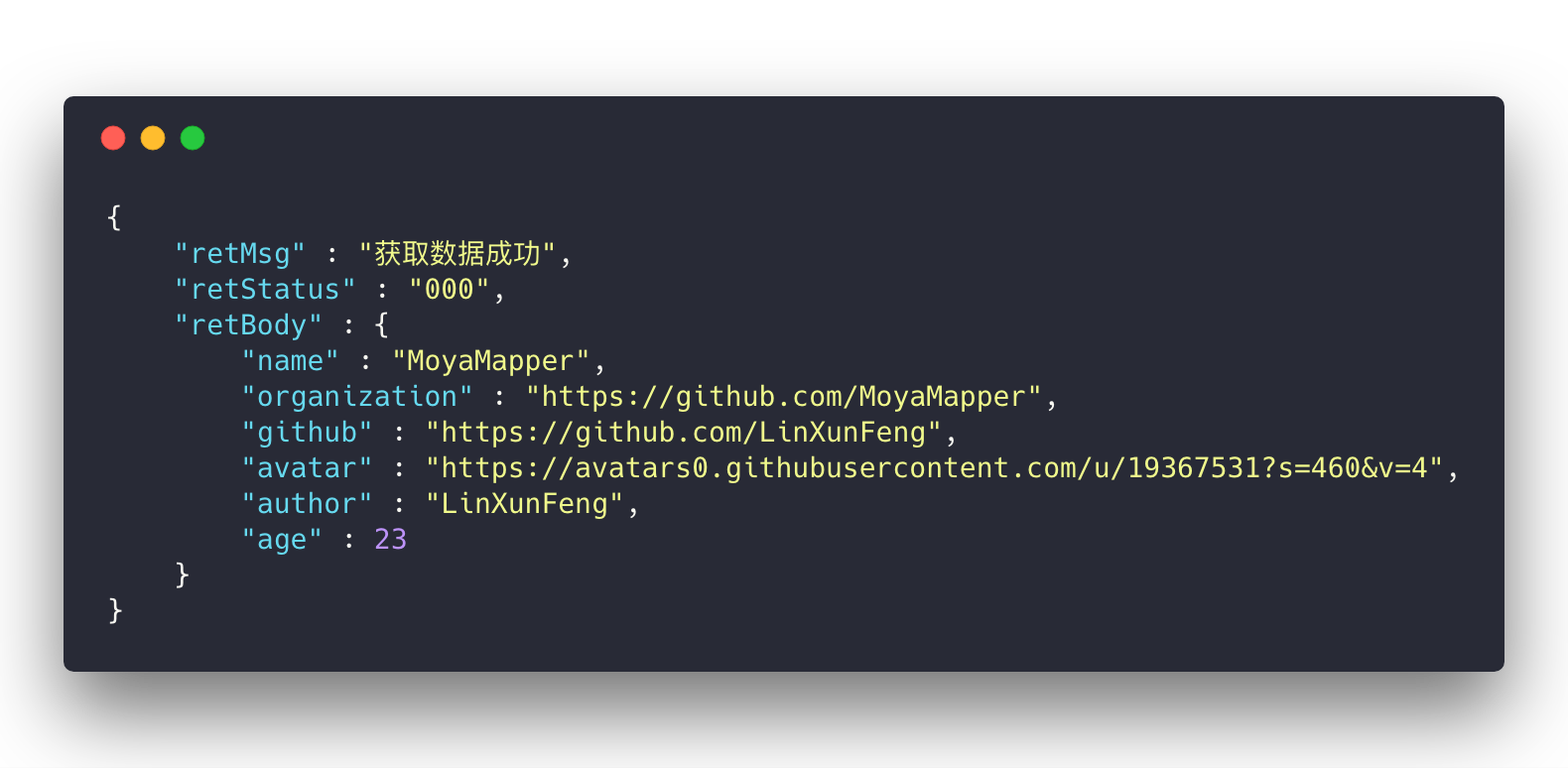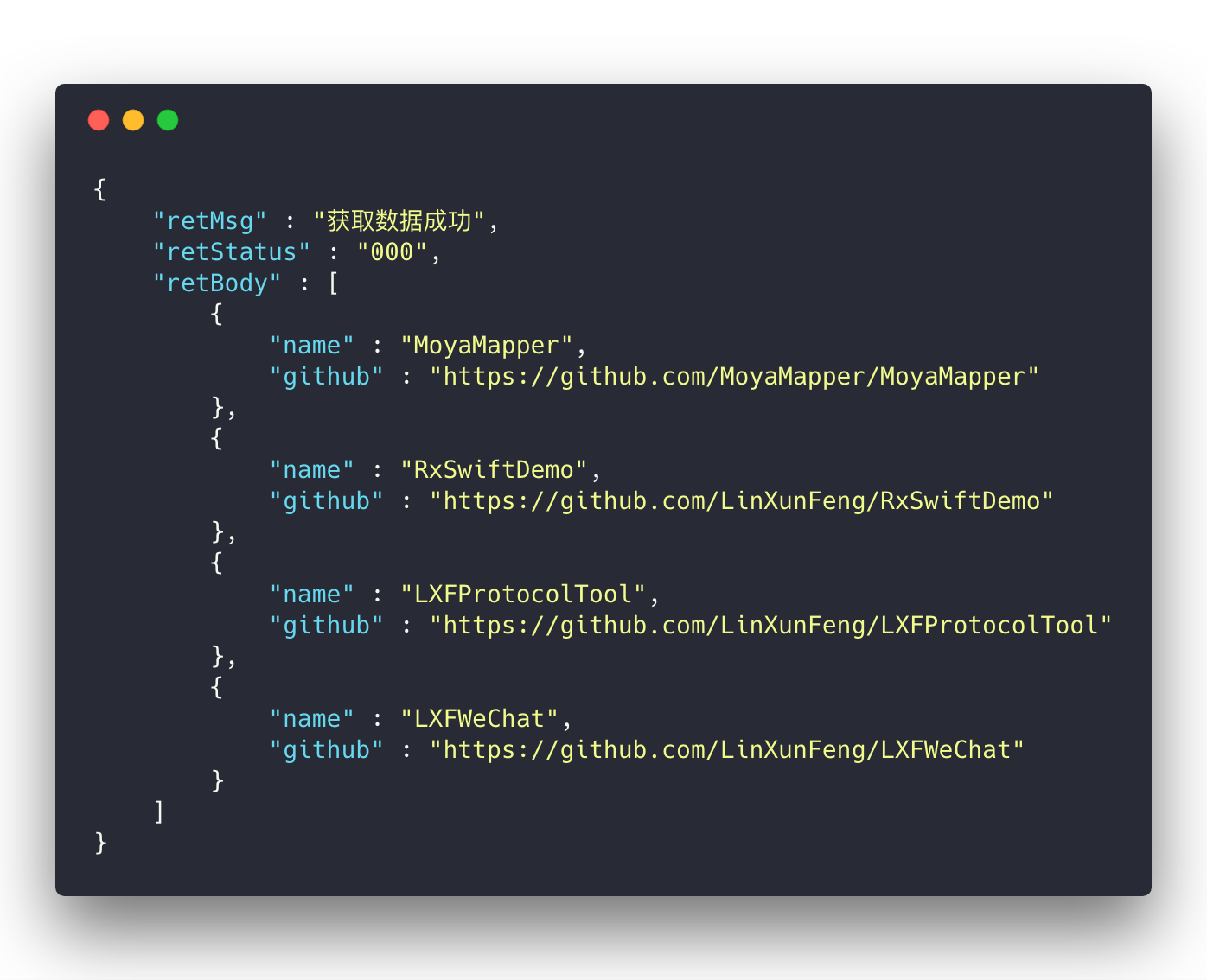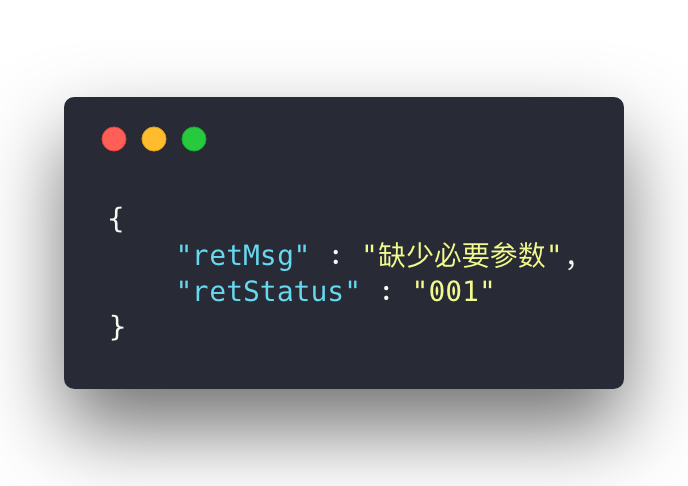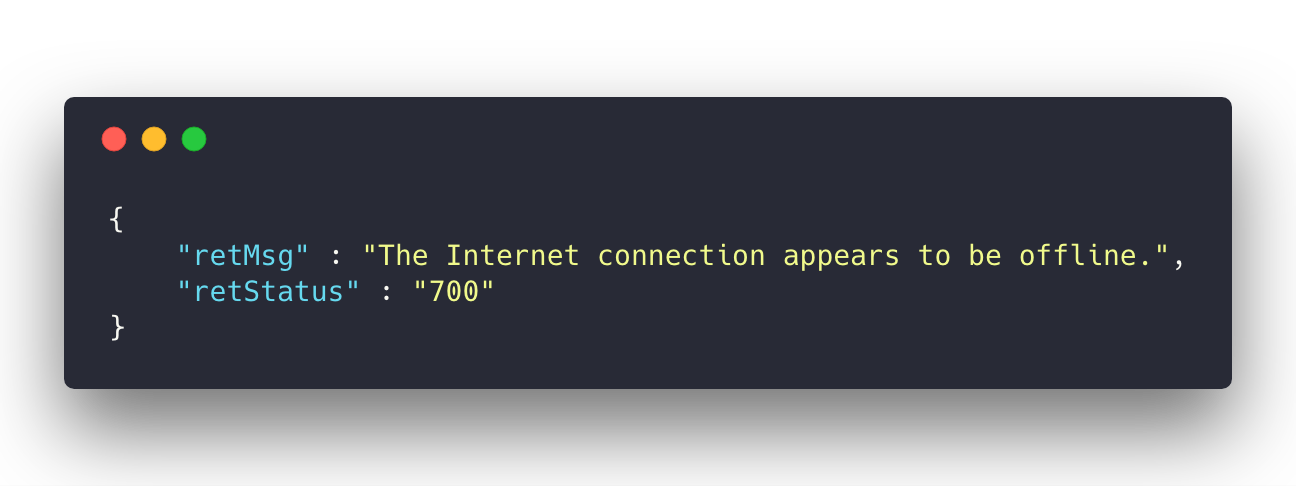 Swift - 掌控Moya的网络请求、数据解析与缓存
Swift - 掌控Moya的网络请求、数据解析与缓存
Moya在Swift开发中起着重要的网络交互作用,但是还有不如之处,比如网络不可用时,返回的Response为nil,这时还得去解析相应的ErrorCodable可以帮助我们快速的解析数据,但是一旦声明的属性类型与json中的不一致,将无法正常解析; 而且对于模型中自定义属性名的处理也十分繁琐
解决的方案有很多,不过我比较习惯使用 MoyaMapper ,不仅可以解决上述问题,还提供了多种模型转换、数据互转、多种数据类型任意存储的便捷方法。掌控Moya的网络请求、数据解析与缓存简直易如反掌。
MoyaMapper是基于Moya和SwiftyJSON封装的工具,以Moya的plugin的方式来实现间接解析,支持RxSwiftGitHub: MoyaMapper (opens new window)
📖 详细的使用请查看手册 https://MoyaMapper.github.io (opens new window)
# 特点
- 支持
json转Model自动映射 与 自定义映射 - 无视
json中值的类型,Model中属性声明的是什么类型,它就是什么类型 - 支持
Data字典JSONjson字符串Model互转 - 插件方式,全方位保障
Moya.Response,拒绝各种网络问题导致Response为nil,将各式各样的原因导致的数据加载失败进行统一处理,开发者只需要关注Response - 可选 - 支持数据随意缓存(
JSON、Number、String、Bool、Moya.Response) - 可选 - 支持网络请求缓存
# 数据解析
# 一、插件注入
附:插件 MoyaMapperPlugin 的详细使用 (opens new window)

1、定义适用于项目接口的 ModelableParameterType
// statusCodeKey、tipStrKey、 modelKey 可以任意指定级别的路径,如: "error>used"
struct NetParameter : ModelableParameterType {
var successValue = "000"
var statusCodeKey = "retStatus"
var tipStrKey = "retMsg"
var modelKey = "retBody"
}
2、在 MoyaProvider 中使用 MoyaMapperPlugin 插件,并指定 ModelableParameterType
let lxfNetTool = MoyaProvider<LXFNetworkTool>(plugins: [MoyaMapperPlugin(NetParameter())])
❗ 使用 MoyaMapperPlugin 插件是整个 MoyaMapper 的核心所在!
# 二、Model声明
Model需遵守Modelable协议
MoyaMapper支持模型自动映射 和 自定义映射- 不需要考虑源json数据的真实类型,这里统一按
Model中属性声明的类型进行转换
1、一般情况下如下写法即可
struct CompanyModel: Modelable {
var name : String = ""
var catchPhrase : String = ""
init() { }
}
2、如果自定义映射,则可以实现方法 mutating func mapping(_ json: JSON)
struct CompanyModel: Modelable {
var name : String = ""
var catchPhrase : String = ""
init() { }
mutating func mapping(_ json: JSON) {
self.name = json["nickname"].stringValue
}
}
3、支持模型嵌套
struct UserModel: Modelable {
var id : String = ""
var name : String = ""
var company : CompanyModel = CompanyModel()
init() { }
}
# 三、Response 解析
1、以下示例皆使用了
MoyaMapperPlugin,所以不需要指定解析路径2、如果没有使用
MoyaMapperPlugin则需要指定解析路径,否则无法正常解析ps:
解析路径可以使用a>b这种形式来解决多级路径的问题
解析方法如下列表所示
| 方法 | 描述 (支持RxSwift) |
|---|---|
| toJSON | Response 转 JSON ( toJSON (opens new window) rx.toJSON (opens new window)) |
| fetchString | 获取指定路径的字符串( fetchString (opens new window) rx.fetchString (opens new window)) |
| fetchJSONString | 获取指定路径的原始json字符串 ( fetchJSONString (opens new window) rx.fetchJSONString (opens new window) ) |
| mapResult | Response -> MoyaMapperResult (Bool, String) ( mapResult (opens new window) rx.mapResult (opens new window) ) |
| mapObject | Response -> Model ( mapObject (opens new window) rx.mapObject (opens new window)) |
| mapObjResult | Response -> (MoyaMapperResult, Model) ( mapObjResult (opens new window) rx.mapObjResult (opens new window)) |
| mapArray | Response -> [Model] ( mapArray (opens new window) rx.mapArray (opens new window)) |
| mapArrayResult | Response -> (MoyaMapperResult, [Model]) ( mapArrayResult (opens new window) rx.mapArrayResult (opens new window)) |
❗除了 fetchJSONString 的默认解析路径是根路径之外,其它方法的默认解析路径为插件对象中的 modelKey
如果接口请求后 json 的数据结构与下图类似,则使用 MoyaMapper 是最合适不过了

// Normal
let model = response.mapObject(MMModel.self)
print("name -- \(model.name)")
print("github -- \(model.github)")
// 打印json
print(response.fetchJSONString())
// Rx
rxRequest.mapObject(MMModel.self)
.subscribe(onSuccess: { (model) in
print("name -- \(model.name)")
print("github -- \(model.github)")
}).disposed(by: disposeBag)
附: fetchJSONString的详细使用 (opens new window)

// Normal
let models = response.mapArray(MMModel.self)
let name = models[0].name
print("count -- \(models.count)")
print("name -- \(name)")
// 打印 json 模型数组中第一个的name
print(response.fetchString(keys: [0, "name"]))
// Rx
rxRequest.mapArray(MMModel.self)
.subscribe(onSuccess: { models in
let name = models[0].name
print("count -- \(models.count)")
print("name -- \(name)")
}).disposed(by: disposeBag)
附:mapArray的详细使用说明 (opens new window)

// Normal
let (isSuccess, tipStr) = response.mapResult()
print("isSuccess -- \(isSuccess)")
print("tipStr -- \(tipStr)")
// Rx
rxRequest.mapResult()
.subscribe(onSuccess: { (isSuccess, tipStr) in
print("isSuccess -- \(isSuccess)") // 是否为 "000"
print("retMsg -- \(retMsg)") // "缺少必要参数"
}).disposed(by: disposeBag)
附:mapResult的详细使用说明 (opens new window)
# 统一处理网络请求结果
在APP的实际使用过程中,会遇到各种各样的网络请求结果,如:服务器挂了、手机无网络,此时
Moya返回的Response为 nil,这样我们就不得不去判断Error。但是使用MoyaMapperPlugin就可以让我们只关注Response
// MoyaMapperPlugin 的初始化方法
public init<T: ModelableParameterType>(
_ type: T,
transformError: Bool = true
)
type : ModelableParameterType 用于定义字段路径,做为全局解析数据的依据
transformError : Bool 是否当网络请求失败时,自动转换请求结果,默认为 true
- 当请求失败的时候,此时的
result.response为nil,根据transformError是否为true判断是否创建一个自定义的response并返回出去。
➡ 本来可以请求到的数据内容

➡ 现在关闭网络,再请求数据
正常情况下,即不做任何不处理的时候,
Response为nil经过
MoyaMapperPlugin处理的后可得到转换后的Response,如图

这里将请求失败进行了统一处理,无论是服务器还是自身网络的问题,retStatus 都为 MMStatusCode.loadFail,但是 errorDescription 会保持原来的样子并赋值给 retMsg。
retStatus值会从枚举MMStatusCode中取loadFail.rawValue,即700- 取 类型为
ModelableParameterType的type中statusCodeKey所指定的值 为键名,retMsg也同理
ps: 这个时候可以通过判断 retStatus 或 response.statusCode 是否与 MMStatusCode.loadFail.rawValue 相同来判断是否显示加载失败的空白页占位图
enum MMStatusCode: Int {
case cache = 230
case loadFail = 700
}
枚举 MMStatusCode 中除了 loadFail ,还有 cache,我们已经知道 loadFail 在数据加载失败的时候会出现,那 cache 是在什么时候出来呢?不急,看下一节就知道了。
# 数据缓存
# 一、基本使用
// 缓存
@discardableResult
MMCache.shared.cache`XXX`(value : XXX, key: String, cacheContainer: MMCache.CacheContainer = .RAM) -> Bool
// 取舍
MMCache.shared.fetch`XXX`Cache(key: String, cacheContainer: MMCache.CacheContainer = .RAM)
缓存成功会返回一个 Bool 值,这里可不接收
| XXX 所支持类型 | |
|---|---|
| Bool | - |
| Float | - |
| Double | - |
| String | - |
| JSON | - |
| Modelable | [Modelable] |
| Moya.Response | - |
| Int | UInt |
| Int8 | UInt8 |
| Int16 | UInt16 |
| Int32 | UInt32 |
| Int64 | UInt64 |
其中,除了
Moya.Response之外,其它类型皆是通过JSON来实现缓存
所以,如果你想清除这些类型的缓存,只需要调用如下方法即可
@discardableResult
func removeJSONCache(_ key: String, cacheContainer: MMCache.CacheContainer = .RAM) -> Bool
@discardableResult
func removeAllJSONCache(cacheContainer: MMCache.CacheContainer = .RAM) -> Bool
清除 Moya.Response 则使用如下两个方法
@discardableResult
func removeResponseCache(_ key: String) -> Bool
@discardableResult
func removeAllResponseCache() -> Bool
再来看看MMCache.CacheContainer
enum CacheContainer {
case RAM // 只缓存于内存的容器
case hybrid // 缓存于内存与磁盘的容器
}
这两种容器互不相通,即 即使key相同,使用
hybrid来缓存后,再通过RAM取值是取不到的。
- RAM : 仅缓存于内存之中,缓存的数据在APP使用期间一直存在
- hybrid :缓存于内存与磁盘中,APP重启后也可以获取到数据
# 二、缓存网络请求
内部缓存过程:
- APP首次启动并进行网络请求,网络数据将缓存起来
- APP再次启动并进行网络请求时,会先返回缓存的数据,等请求成功后再返回网络数据
- 其它情况只会加载网络数据
- 每次成功请求到数据后,都会对缓存的数据进行更新
// Normal
func cacheRequest(
_ target: Target,
cacheType: MMCache.CacheKeyType = .default,
callbackQueue: DispatchQueue? = nil,
progress: Moya.ProgressBlock? = nil,
completion: @escaping Moya.Completion
) -> Cancellable
// Rx
func cacheRequest(
_ target: Base.Target,
callbackQueue: DispatchQueue? = nil,
cacheType: MMCache.CacheKeyType = .default
) -> Observable<Response>
实际上是对
Moya请求后的Response进行缓存。 其实与Moya自带的方法相比较只多了一个参数cacheType: MMCache.CacheKeyType,定义着缓存中的key,默认为default
下面是 MMCache.CacheKeyType 的定义
/**
let cacheKey = [method]baseURL/path
- default : cacheKey + "?" + parameters
- base : cacheKey
- custom : cacheKey + "?" + customKey
*/
public enum CacheKeyType {
case `default`
case base
case custom(String)
}
如果你想缓存
多页列表数据的最新一页数据,此时使用default是不合适的,因为default使用的key包含了pageIndex,这样就达不到只缓存最新一页数据的目的, 所以这里应该使用base或者custom(String)
我们可以来试一下带缓存的请求
/*
* APP第一次启动并进行网络请求,网络数据将缓存起来
* APP再次启动并进行网络请求时,会先加载缓存,再加载网络数据
* 其它情况只会加载网络数据
* 每次成功请求到数据都会进行数据更新
*/
lxfNetTool.rx.cacheRequest(.data(type: .all, size: 10, index: 1))
.subscribe(onNext: { response in
log.debug("statusCode -- \(response.statusCode)")
}).disposed(by: disposeBag)
// 传统方式
/*
let _ = lxfNetTool.cacheRequest(.data(type: .all, size: 10, index: 1)) { result in
guard let resp = result.value else { return }
log.debug("statusCode -- \(resp.statusCode)")
}
*/
打印结果
// 首次使用APP
statusCode -- 200
// 关闭并重新打开APP,再请求一下
statusCode -- 230
statusCode -- 200
// 然后再请求一下
statusCode -- 200
这里的 230 就是 MMStatusCode.cache.rawValue
# CocoaPods
- 默认安装
MoyaMapper默认只安装Core下的文件
pod 'MoyaMapper'
- RxSwift拓展
pod 'MoyaMapper/Rx'
- 缓存拓展
pod 'MoyaMapper/MMCache'
- Rx缓存
pod 'MoyaMapper/RxCache'

- 01
- Flutter 多仓库本地 Monorepo 方案与体验优化10-25
- 02
- Flutter webview 崩溃率上升怎么办?我的分析与解决方案10-19
- 03
- Flutter - Melos Pub workspaces 实践10-12
